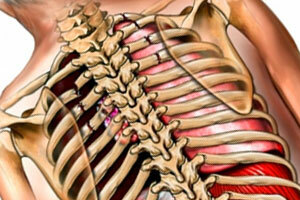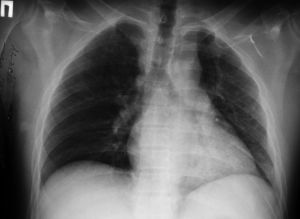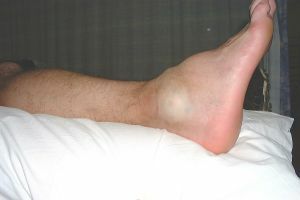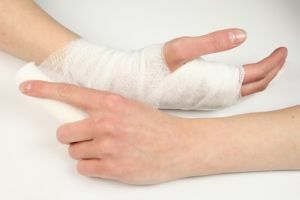 Chest bruise is a common type of injury that traumatologists and surgeons often encounter.
Chest bruise is a common type of injury that traumatologists and surgeons often encounter.
Characterized by soft tissue damage, often with swelling and inflammatory changes.
Serious injuries are possible with a violation of bone integrity and damage to internal organs.
Contents of the article
- Features of ICD injury 10
- Species and features of injuries
- How to identify a bruise?
- First aid
- Objectives and therapies
- Conventional methods
- Complications and consequences
- Rehabilitation
Features of ICD injury 10
In the International Classification of Diseases of the Tenth Revision( ICD 10), the chest contusion is treated as:
- external - S 20;
- open wounds - S 21;
- fracture of ribs and sternum - S 22;
- distortion and dislocation of capsular - ligamentous apparatus - S 23;
- spinal cord and nerve damage - S 24;
- trauma of blood vessels - S 25;
- damage to the heart muscle - S 26;
- , unspecified injury or damage to other organs - S 27;
- crushing of the thorax - S 28;
- , unspecified - S 29.
Depending on the cause, severity, the doctor in the diagnosis only indicates the disease code according to the ICD 10, without specifying the clinical picture.
According to the international classification, the chest injury is recorded as S 22.
Species and features of injuries
Breast trauma can be divided into two types: open and closed.
Closed injuries are most commonly encountered, the characteristic feature of which is the absence of a superficial wound. Such injuries include:
- trauma, in which there are no changes in the chest;
- various types of bruises with possible damage to internal organs: bruise of blood vessels, heart, lung rupture, pneumothorax, hemothorax, broken ribs and sternum, thoracic vertebrae;
- traumatic asphyxia, which causes suffocation due to severe compression.
Such wounds are significantly different in nature, location, severity of damage to soft tissues and internal organs:
- Contusions .Do not have any serious damage and are characterized by hematoma and pain, worse with coughing. Special treatment does not require
 .In some cases, there is a bleeding in the cavity or tissues of the chest, which requires urgent hospitalization.
.In some cases, there is a bleeding in the cavity or tissues of the chest, which requires urgent hospitalization. - Concussions .In the absence of anatomical changes, there is a severe shock in the patient. Breath shallow, shallow. Pulse accelerated, uneven. Limbs are cyanotic, cold. Urgent hospitalization is required.
- Compression of .Violated breathing movements, there is a flow of blood from the forearm, head, upper part of the sternum. Develops suffocation. Possible loss or disturbance of consciousness, in addition, temporary loss of sight and hearing. The patient must be hospitalized in a semi-sitting position.
- Hemotorax .Due to severe damage to the intercostal vessels, the internal thoracic artery, the lungs, it is possible to concentrate blood in the pleural cavity. Small and medium hemothorax is characterized by a slight deterioration in the condition of the victim, conservative treatment is allowed. With a strong accumulation of blood in the patient is a shock. Regardless of the degree of hemothorax, patients are hospitalized without fail.
- Pneumothorax .If the lung is damaged in the pleural cavity, air( pneumothorax) accumulates, which leads to a worsening of the condition. There is shortness of breath, respiratory distress, choking.
- Fractures of the ribs .The most common injuries to chest injuries. The most common are people of middle and old age. In children, due to the elasticity of bone structures, such a trauma is rare. The main complaint is acute pain in the place of impact, which increases with breathing. During palpation, crepitation of bone fragments is revealed, but this research should be carried out delicately so as not to do more harm and not cause traumatic shock. The greatest damage is possible with multiple fractures of the ribs. Breast Fracture. It occurs very rarely. In addition to local pain syndrome, there is mobility in the place of trauma and hematoma. Closed injury with damage to internal organs. In most cases, it combines the wound of the internal organs and the chest wall. Such an injury is called a combination. Most people experience shock, a breathing disorder occurs.
- Damage to the lung .Occurs mainly when wounded with sharp fragments of broken ribs. The clinical picture depends on the size of the injury. With a small rupture, the wound closes relatively quickly, blood and air do not enter the pleural cavity. It is impossible to detect such a wound visually.
How to identify a bruise?
The chest injury can not be overlooked, it's impossible, the symptoms appear right after the stroke.
The main signs of injury:
- sharp pain, which is aggravated by inhalation;
- in the place of injury, bruising and cyanosis occur;
- with hematoma may appear swelling of soft tissues;
- in the damaged area can be palpated by a seal.
In cases where the injury is accompanied by serious damage, the symptomatology is more pronounced. Skin covers are pale, dizziness, dyspnea. With severe pain, shock and respiratory arrest may occur.
If the blow fell on the right side, then it can lead to a lung injury.
First aid
 If the chest is bruised, the patient immediately needs to provide first aid.
If the chest is bruised, the patient immediately needs to provide first aid.
The victim is helped to take a comfortable position, provide complete peace, apply a cold compress to the injured place.
Cold reduces hemorrhage and swelling of soft tissues.
Aims and methods of treatment
If the chest contusion is superficial, its treatment is possible at home. The patient is recommended to apply cold to the place of injury, but not more than 15 minutes.3-5 rubles per day.
On the third day, cold compresses are changed to warm, for example, a heating pad or a bathroom.
Folk remedies can also be used in combination with classical methods.
Ointment recipes:
- For the treatment of a simple soft tissue injury: mix honey with fresh aloe juice, moisten the bandage and apply to a sore spot.

- Wipe the place on a fine grater, mix with raw egg yolk. Lubricate the bruise 2 r. / Day.
It is recommended to use infusions of any medicinal herbs on alcohol. Alcoholic medicinal tinctures have a warming, analgesic and anti-edematous effect.
Recipe: 100 g of herbs are poured with 0.5 liters of vodka or alcohol, insist the mixture for at least 3 days and use as a compress.
Traditional methods
After hospitalization, the diagnosis is set, the specialist prescribes complex treatment.
In some cases, the patient is placed tight bandages on the entire area of the sternum. This will help to somewhat reduce the pain syndrome during movement and will facilitate breathing.
In addition, depending on the symptoms, specialists prescribe ointments:
- pain relievers - for severe pain;
- anti-inflammatory - for the removal of edema;
- thrombolytic - for resorption of blood clots in veins.
If the injury is severe and is characterized by ICD-10 as S 26-28, the patient is left in the hospital. If necessary, puncture the pleural cavity to remove air and blood.
In this case, the following treatment is performed:
- cold and warm compresses;
- permanent analgesic and anti-inflammatory therapy;
- application of a special bandage to limit mobility;
- physiotherapy;
- , if necessary, an operation is performed to sew large vessels.
Complications and consequences
Usually, all damage is completely gone within 2-3 weeks. If the injury was serious, then on the spot of the hematoma for a long time the compaction may persist.
Consequences of the impact can affect the work of the respiratory system( shortness of breath, heavy breathing), lead to chronic lung diseases.
When striking the heart, cardiac vessels could be injured, which leads to a post-traumatic thrombus.
Rehabilitation
 The recovery process depends on the severity of the injury. If the injury did not carry serious damage, the recovery occurs after 5-8 days of .
The recovery process depends on the severity of the injury. If the injury did not carry serious damage, the recovery occurs after 5-8 days of .
If the injury was accompanied by serious injuries, recovery may take up to a month. For the fastest recovery the patient is offered to undergo a complex of physiotherapy procedures.
After healing of the fractures, it is necessary to gradually pass to an increase in the loads. Rehabilitation exercises are conducted only under the supervision of a specialist.
Do not forget that even after a full recovery, there is a risk of repeated fractures and bruises, so keep the chest from overloading.
Therefore, for any, even the most minor injuries of the chest, it is necessary to consult a specialist and undergo a complete examination.



